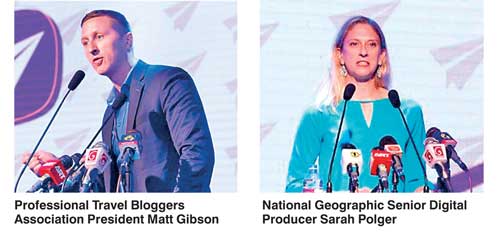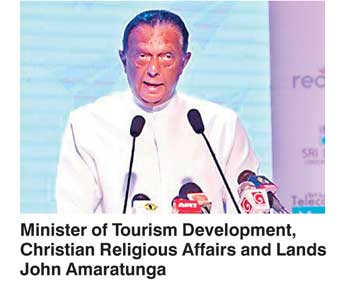Monday Nov 03, 2025
Monday Nov 03, 2025
Wednesday, 8 June 2016 00:00 - - {{hitsCtrl.values.hits}}
By Himal Kotelawala
TBCasia 2016, a six-day event centred on travel blogging organised by Cinnamon Hotels & Resorts together with SriLankan Airlines in collaboration with the Professional Travel Bloggers Association (PTBA), culminated in a conference and awards ceremony held at the Cinnamon Grand yesterday.
Held from 2 to 7 June, TBCasia 2016 saw the participation of 60 international travel writers, photographers and video-bloggers from around the world who had each amassed a sizeable following on social media across various platforms.
The Daily FT, too, was invited to take part in a five-day pre-Conference familiarisation tour that saw a team of 12 bloggers discovering the east coast of Sri Lanka for the first time, from Arumgam Bay and the Kumana National Park, to Batticaloa and Passikudah and Pigeon Island off Trincomalee. A detailed report on this excursion will appear in this newspaper on Friday. (The 60 bloggers were split into four groups, each of which set out to explore a different, predetermined region of the island leading up to the conference).
Yesterday’s conference brought together the 60 bloggers and around 300 local and foreign players in the travel and tourism sector, both private and public, in an effort to “explore and evaluate the impact of travel blogging” in global tourism in the age of hashtags and likes.

Changing the conversation across Asia
PTBA President Matt Gibson speaking at the event said that the first-ever TBC held in 2014, also put together with the assistance of Cinnamon, was the largest organised travel-influencer trip in history, amounting to 49 million impressions for the #TBCasia hashtag on Twitter and Instagram, during and after the conference. This year’s event had already surpassed 50 million pre-conference, he claimed.
“Three years ago, in Asia, it was almost unheard of for an influencer to be able to speak to a travel company or a tourism board and find paid work. It just wasn’t happening. A lot of us loved to travel here, but we weren’t getting jobs here. The first TBCasia changed that,” said Gibson.
This helped decision makers realise that influencer-marketing was of value and that they ought to be working with bloggers, Instagrammers and YouTubers, said Gibson.
“It changed the conversation across Asia. It had a huge impact. Since then we have seen an incredible amount of progress. The PTBA has started getting invited to events to speak across the board. We are now getting requests from tourism boards to bring bloggers on press trips to their countries for the first time. This is in large parts thanks to the thought leadership of Cinnamon and the courage that it took to put together such an enormous event,” he said.
Go digital now
Delivering the keynote address, Senior Digital Producer at National Geographic Sarah Polger said that the right time for the travel industry to go digital is right now.
“My job is to inspire people to explore the world. From photography, to travel and digital storytelling, these are passions that drive me and my colleagues to come in to office every day. There is no better time than right now to be working in digital, and the options are endless,” she said, presenting NatGeo’s rather impressive numbers for its various online platforms.
Explaining the company’s reasons for putting together the event and its desire to seek out ‘earned reputation’ (as opposed to bought reputation) in a panel discussion towards the end of the conference, Cinnamon Vice President and Head of Brand Marketing Dileep Mudadeniya said that, for any travel related business, getting into digital and influencer or referral marketing is something that can no longer be put on hold.
“Not getting into [digital] is not a question. We’re into service marketing. We’re selling an intangible product. The customer is looking to buy something he or she doesn’t know much about and will need some kind of reassurance. That’s the birth of referral marketing and influencer marketing,” he said.
More than a mere room
Customers are increasingly on the lookout for something more than a mere room, said Mudadeniya.
“They need experiences; they need things to do around the hotel; they need assurance. That’s how we came to see the growth of travel blogging that nobody seemed to be taking advantage of. The entire [marketing] team went through this and understood that there was a market opportunity there,” he said.
The PTBA had, according to Mudadeniya, initially felt that the project was too ambitious.
“But there was scope, and that created a platform for us to go and relate a story that people would believe. In advertising, people may or may not believe your message, but here it’s an influencer, a trusted third party, that’s delivering that message on your behalf. That trust can relate to brand awareness. That influencer process is something we’re looking at. In advertising this is called buying reputation, whereas here, it’s called earning reputation. Earned reputation is what you need in the intangible service market,” he explained.
By Himal Kotelawala
The Government intends to see a 50% increase in per capita spending of tourists coming into Sri Lanka by 2020, Tourism Minister John Amaratunga said yesterday.
Speaking at the TBCAsia 2016 travel bloggers conference organised by Cinnamon Hotels & Resorts, the Minister said that online platforms such as TripAdvisor, LonelyPlanet, Kayak and Air BnB are revolutionising the way Sri Lanka is marketed in the modern age.
Air BnB, in particular, is already listing around 500 properties – i.e. private homes and apartments – in Sri Lanka, he said, adding that it is clear that times are changing and Sri Lanka must change or be left behind.
“With the entry of top international brands like Anantara, Sheraton, Movenpick, Hyatt Regency, Shangri-La, Marriot, and ITC in the near future, we want to increase the per capita spending of tourists by at least 50% by 2020. We must also use the new channels to promote our MICE (Meetings, Incentives, Conferences and Events) capability, which is somewhat lagging at the moment,” he said.
Recalling remarks made by Prime Minister Ranil Wickremesinghe at the Golden Jubilee celebrations of Sri Lanka Tourism last month highlighting the strategic plan for tourism development in this country, Amaratunga said that tourism as Sri Lanka has experienced it over the past 50 years will see a “drastic change” going forward.
“While we have come a long way these 50 years, it seems the real challenge is only just beginning,” he said.
The Minister invited the private sector to play a more proactive role in developing tourism in Sri Lanka.
“Tourism is growing at a rate of 20% year-on-year but we do not want to be complacent and I call upon the private sector, just like in this instance, to take the lead in showing the way forward. We must reach out and tap the full potential of our Asian neighbours, India and China in particular, while not forgetting the powerful group that is known as the Asian Millennials,” he said.